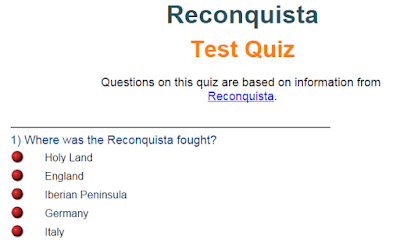"I never teach my pupils. I only attempt to provide the conditions in which they can learn" Einstein
Thursday 30 November 2017
Monday 27 November 2017
Saturday 25 November 2017
Monday 20 November 2017
Social Sciences. Unit 5. Spain in the Middle Ages. The Reconquista.
RODRIGO DÍAZ DE VIVAR, EL CID CAMPEADOR
 Rodrigo Díaz de Vivar was an important figure in the history of the Reconquista. He was also known as El Cid Campeador (Cid, from the Arabic, means "lord").
Rodrigo Díaz de Vivar was an important figure in the history of the Reconquista. He was also known as El Cid Campeador (Cid, from the Arabic, means "lord").
He was born in Burgos, in the Kingdom of Castilla, in about 1043. He became a military commander and fought for King Sancho II against the Muslims. He also helped Sancho to fight against his brother, King Alfonso VI of León. But then Sancho died and Alfonso became King of Castilla.
El Cid served King Alfonso VI until he was banished (le desterraron) from his kingdom in 1081. The tale of his exile and his exploits (hazañas) are told in "The Song of the Cid" (El Cantar de Mio Cid), a poetry book written after his death. This poem made him a national hero.
El Cid took control of Valencia in 1094 and he established an independent señoria.
His battle horse was called "Babieca". They had a horse for battles and another one for travelling, and would change horses quickly if they had to fight, so that their best one would not be tired from the journey.
He died in Valencia in 1099. Legend says that after El Cid died he was strapped (atado con cuerdas) into his horse and sent into battle against Muslims.
After his death, the city of Valencia resisted the Almoravid assault for two more years, under the rule of El Cid's widow, Jimena.
El Cid's sword "Tizona" can still be seen in Burgos Museum.
Here you have a web in Spanish with games, comics and much more staff about El Cid.
Here you've got an animated film about El Cid and a TV animated serie. Enjoy!!
Social Sciences. Unit 5. Spain in the Middle Ages. What was the Reconquista?
THE RECONQUISTA
When the Muslims created al-Andalus, many Christians moved to the mountains in the north. Here was where Visigoth noble Pelayo defeated the Muslims in Battle of Covadonga in 722 A.D. and the Reconquista began.
After that, Don Pelayo established the Kingdom of Asturias. Later on this kingdom became the Kingdom of León. There were other Christian kigdoms too, such as the Kingdoms of Castilla, Navarra and Aragón.
 |
| Statue of Don Pelayo in Covadonga (Asturias) |
From the 8th and the 15th
centuries, the Christian kingdoms expanded in to the south. They
conquered lands from al-Andalus. This process is called the Reconquista.
Christians wanted to conquer al-Andalus for three reasons:
- The Christian kings needed more land for growing crops, raising animals and because the population was increasing.
- The Christians kings thought the lands of al-Andalus should be ruled by Christians, as in the times of the Christians Visigoths.
- After al-Andalus was divided into small taifa kingdoms, it was easier to conquer them.
During this time, despite the fights for the Reconquista, Muslims, Christians and Jews lived together and established a rich excange between cultures.
Alfonso VI was King of Castilla and León. In 1085 he conquered Toledo from the Muslims. It was a very important victory for the Christian armies because Toledo was a strategic area and a symbol of Christianity from the time of Visigoths.
 |
| Alfonso VI conquered Toledo, 25th may 1085. Banco de la Plaza de España de Sevilla |
In 1212 the Christians won the Battle of Navas de Tolosa in Jaén.
 |
| El Llibre del Fets. Autobiographical chronicles of James I The Conqueror.
Fernado III was King of Castilla y León. He conquered Córdoba in 1236 and Sevilla in 1248.
|
 |
| Fernando III, King of Castilla and León. |
Granada was the last Muslim Kingdom in the Iberian Peninsula. In 1492 king Fernando II of Aragón and Isabel I of Castilla, known as the Catholic Monarchs, conquered Granada. The Christian Reconquest was completed.
In the following picture we can see King Boabdil surrenders the Kingdom of Granada to the Catholic Monarchs.
 | |
| La Rendición de Granada by F. Pradilla (1882). This picture is found in the Palacio del Senado (Madrid). |
Click on the image below and you'll know the main characters of the Fall of Granada.
Here you have a famous Spanish TV serie where you can see this important event in the History of Spain.
FALL OF GRANADA (1492) The last taifa kingdom (Granada, Málaga and Almería)
The Muslims conquered most of the Iberian Peninsula from the Visigoths in only few years. But it took the Christians nearly 800 years to reconquer the peninsula from the Muslims!
EXERCISE. Write true
or false. If it is false, write the right sentence.
1. It took about 100 years for the
Christian kings to conquer al-Andalus.
2. The Christian kingdoms were
expanding because they needed more land.
3. King Jaime I of Aragón conquered
Granada in 1492.
4. In 1212 The Muslims won an
important battle against the Christians.
Subscribe to:
Posts (Atom)












